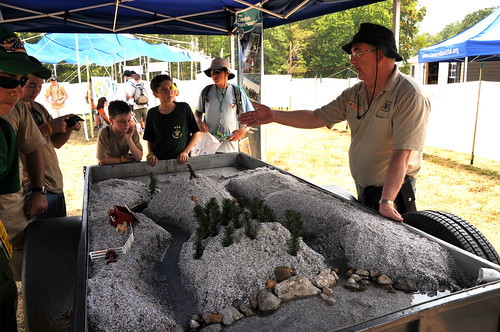
For the USDA Forest Service, looking back at this landmark Centennial Boy Scout Jamboree is not about the numbers: it is about the heart of future generations and how they will see, understand, care for, and respect the natural resources. The agency has a longstanding history and partnership with Scouts, dating back decades. Scout troops, Districts and national groups like Arrow 5, a special Eagle Scout organization, donate thousands of volunteer hours in recreation and natural resource work on national forests and grasslands.
Here are some observations on this year’s event from some of the staff and volunteers:
“Scouts were introduced to the concept of an all-lands approach to conservation having the opportunity to visits with over a dozen different government land management agencies and other conservation organizations located all together here at the Jamboree Conservation Trail.”
“…we had Scouts visit our Jamboree NF exhibit from every state in our nation plus Scouts from every foreign country who attended the Jamboree.”
“…with few exceptions everyone liked what we did; wants the Forest Service to put the script for the Decision Trail* on the web, wants us to be at the World Jamboree in Sweden next year, wants us to be at the 2013 National Jamboree as a permanent exhibit, and the list goes on and on.”
(*the Decision Trail is the conservation and land management challenge Scouts faced in traveling different paths through the Jamboree National Forest set up at the Jamboree.)
“On the last full day of the Jamboree scouts wrapped up merit badge work they had started earlier in the week. In the Conservation Trail area forestry, bird watching and botany were some of the favored science-related subjects scouts focused on. They learned about how to conserve our natural resources and how to manage those resources for sustainability.”
Also during the Jamboree one of the staff members, Tim Beaty, was awarded the Hornaday Gold Medal. The medal is the highest individual conservation award presented to an adult scouter for outstanding service in natural resource conservation and youth education on a multistate or national basis.
The immediate numbers, if you are keeping score at home, are impressive: more than 20,000 Scouts completed merit badges in birding, forestry, plant science, and pulp & paper; more than 70,000 came through the Conservation USA, Outdoor Ethics, and Venturing displays and exhibits; more than 31,000 viewed the Hornaday conservation exhibit.
But even Tim Beaty will tell you it is not about the numbers: It is about the continuation of the planned and collaborative care of our natural resources from an all-lands perspective and across boundaries, as the Scouts learned over the 10-day Jamboree. It is about the knowledge, experience and understanding passed on by the 67 volunteers and Forest Service employees and retirees, each of whom worked 11 or 12 hours a day throughout the entire Jamboree. And it is about the future of the Forest Service and the care of our nation’s natural resources that will, over time, transition into a new set of hands – and certainly some of those hands will come from the ranks of today’s Scouts.

